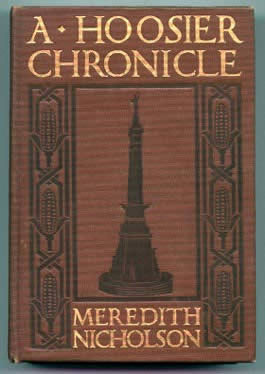Meredith Nicholson was born in Crawfordsville
to a Civil War veteran and a nurse. Nicholson was fascinated
by the Civil War, as well as by Indiana natives, whom he found
friendly and hospitable. These qualities would be reflected
by the characterizations in his later novels.
Nicholson was also deeply interested in politics
and law. When he was nineteen, he studied law in Indiana at
the office of Dye and Fishback. During this time he began
to experiment with writing, eventually becoming a member of
the Indianapolis News editorial board. Nicholson
also served as a diplomat from the U.S. to Nicaragua, Paraguay,
and Venezuela until he retired in Indianapolis.
It was during his years
as an author, however, that he won the most fame. His topics
varied greatly, featuring everything from political discussion
to environmental concerns. A Hoosier Chronicle
is one of his most famous books.
Early in the novel Nicholson compares Indiana
to both Egypt and Italy: "There is always corn in their
Egypt, and no village is so small but it lifts a smokestack
toward a sky that yields nothing to Italy's (7)." Nicholson
clearly feels a deep pride for his native state.
 |
1912 edition
of A Hoosier Chronicle |
Nicholson seemed quite satisfied with the landscapes
of Indiana and the way they had had altered by its settlers.
The state seal, he writes, depicts "a sturdy pioneer
felling a tree while behind him a frightened buffalo
gallops madly into oblivion" (534). This description
is more revealing than Nicholson might have meant it to be.
It demonstrates the lingering attitude that nature was something
wild to be tamed and portrays the settlers as heroic conquerors.
In another novel, The
House of a Thousand Candles, Nicholson provides
us with the view of an outsider coming to Indiana. The character's
expectations of Indiana life are fairly low, and he is surprised
often. When he comes to the place where he will be staying,
he reflects, "To find an apartment so handsome and so
marked by good taste in the midst of an Indiana wood,
staggered me" (44). The outsider has expected to find
only the rustic and outmoded, but is pleasantly surprised.
In fact, he soon begins to feel sympathy for nature. When
he comes to a concrete wall, standing in stark contrast to
nature's beauty, he reflects that there were "much more
satisfactory ways of spending money than in building walls
around Indiana forests" (68). Though he speaks less of
the environment as the novel draws on, the constant references
to weather and scenery makes its presence felt.
Finally, in his novel
Otherwise Phyllis, Phil is an ornithologist,
giving her a unique knack for noticing the environment. Nicholson
writes, early in the book, "Phil turned, half-unconsciously,
and glanced up at the sycamore. That hoary old landmark defined
a boundary" (7). She sees her world in terms of its relationship
to nature. Agriculture
is also important in the novel—it is seen as a sacred
kind of bond between humankind and the land. Fred Holton,
a farmer, observes,
[I]n the very soil itself, he felt a kinship, born of a
hidden, elusive, cramped vein of poetic feeling that lay
deep in his nature. All life, he vaguely realized, is of
a piece: man and the earth to which he is born respond to
the same laws.... He was wedded to this land; his hope was
bound up in it; and he meant to serve it well. (111)
It is little wonder that Nicholson, who lived
his live largely in Indiana, had such powerful feelings toward
the land. His outlook on life and the natural world is expressed
through a variety of viewpoints, characters, and situations
in his novels.
--AHM
Sources:
Nicholson, Meredith. A Hoosier
Chronicle. Boston: Houghton Mifflin, 1912.
---. The House of a Thousand Candles.
New York: A. Wessels Company, 1907.
---. Otherwise Phyllis. Boston:
Houghton Mifflin, 1913.
Russo, Dorothy R., and Thelma L. Sullivan.
Seven Authors of Crawfordsville, Indiana. Chicago:
Lakeside P, 1952.
Images:
"'...and touch the universal
heart.' The Appeal of James Whitcomb Riley." The Lilly
Library: Indiana U Libraries. 3 Oct. 2002 <http://www.indiana.edu/~liblilly/riley/docs/9_nicholhow.html>.
"Rare Books." Pallette and
Print. 2000. 3 Oct. 2002 <http://www.paletteandprint.net/bksrare.html>.
Links:
Meredith
Nicholson Collection, 1890-1942
|




